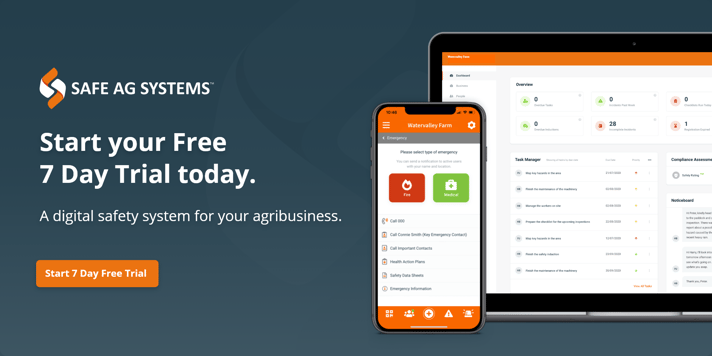Drought. Fires. COVID-19. Tariffs. Aussie farmers have been hit hard recently and it’s become apparent that so many are not adequately prepared.
The same can be said for safety. We hope nothing goes wrong for anyone, and undoubtedly you have insurance, but are you prepared? And the bigger question, will you see a return for the effort and investment needed to bring things up to scratch?
Let’s look at something tangible – it’s time for a new tractor. You’ve done the sums and worked out you can afford to spend the best part of $300K. You know it’ll give you a return on investment over a certain period of time, and there’s plenty of calculators you can use to work this out.
When it comes to work health and safety, the calculations for ROI aren’t quite as straight forward or tangible.
There are direct costs associated with an incident including:
-
Workers compensation – claims experience has a direct effect on premiums both at an individual and industry level
-
Medical bills
-
Property damage and loss
-
Legal fees
-
Penalties issued by safety regulators
There are also indirect costs, which are much harder to factor. These can include:
-
loss of experienced labour
-
disruption to operations
-
reduced morale
-
damaged business reputation
Did you know?
Agriculture remains the deadliest industry in Australia with 40 agricultural workers not going home after work in 2018.
With 3% of the Australian workforce, agriculture had 20% of the fatalities.
The average time lost for a claim in agriculture is 5.7 weeks and the average cost of a claim is $11,100.
Source: Safe Work Australia - Australian workers’ compensation statistics 2017–18
It’s hard to quantify an ROI for safety with so many variables but the good news is there will most likely be a positive return. Studies of CFOs in the US and Europe suggests for every $1 invested in safety management, returns range from $2 to $4.41.

How to demonstrate the ROI of safety to your management team
When attempting to demonstrate the ROI of a safety management system, many people working in agriculture have no idea where to start.
Safe Ag Systems has found that it often comes down to workers not having access to the right tools to consistently capture information and as a result, administrators are unsure what safety metrics they should be tracking in the first place.
Implementing a system like Safe Ag Systems, you immediately begin capturing the data you need to help prove an actual ROI on your safety program. Simple daily actions like completing an induction, inspection, adding a new maintenance record or any other type of safety activity can all be used to identify what improvements are taking place and what is working.
What does the research say?
European research suggests that the average cost for a minor incident is 16 times more than the cost of prevention. For more serious incidents that factor is up to 48.

Naturally you want the best ‘bang for your buck’ when you invest in anything. It’s not different here. There are investments that will give you a quick win, and those which give you long term gains. OSHA estimates safety technology can reduce injuries by 15-35% compared to employers with no system in place.
Make smarter decisions
Knowing the end goal will guide smart investment decisions. Whatever you invest in should align with your overall business goals and be aimed at:
-
Improving safety
-
Managing risks
-
Improving compliance
Smart investment will cover most of these in each thing you do. Get some policies in place, develop safe work procedures, get the right safety equipment and PPE.
You should also ensure you’ve got an emergency response plan for when something does go wrong. Training your workforce is always a good investment. The higher the competence level, the less likely for a serious incident to occur.
06 Steps to managing safety in agriculture. How many are have you got covered?
When can you expect to receive ROI?
You may not know what you’ve managed to prevent so it’s hard to see the savings from incidents. The timeframe over which you are measuring the investment needs to be considered also. What you should expect to see is less lost time injuries, less damage to plant and equipment, less staff attrition meaning better productivity.
A report produced for Safework Australia in 2014 concluded that research generally supports the idea that investing in stronger WHS practices will provide a positive return on investment. Reduced costs associated with poor WHS outcomes and improved productivity will add value to a business. Safework Australia: Workplace Health and Safety, Business Productivity and Sustainability
Is it worth it?
Let’s not beat around the bush. Implementing good safety practices in your business IS going to be an investment, but is it worth it?
Absolutely! It will be of benefit from a financial perspective. But knowing your family, friends and workers go home safe each day – that’s priceless.
Topics: Safety Management System
Disclaimer: Content on this website may be of relevance to users outside of Australia, but content links and examples are specific to Australia. Please check with your local authority for your country and industry requirements.











